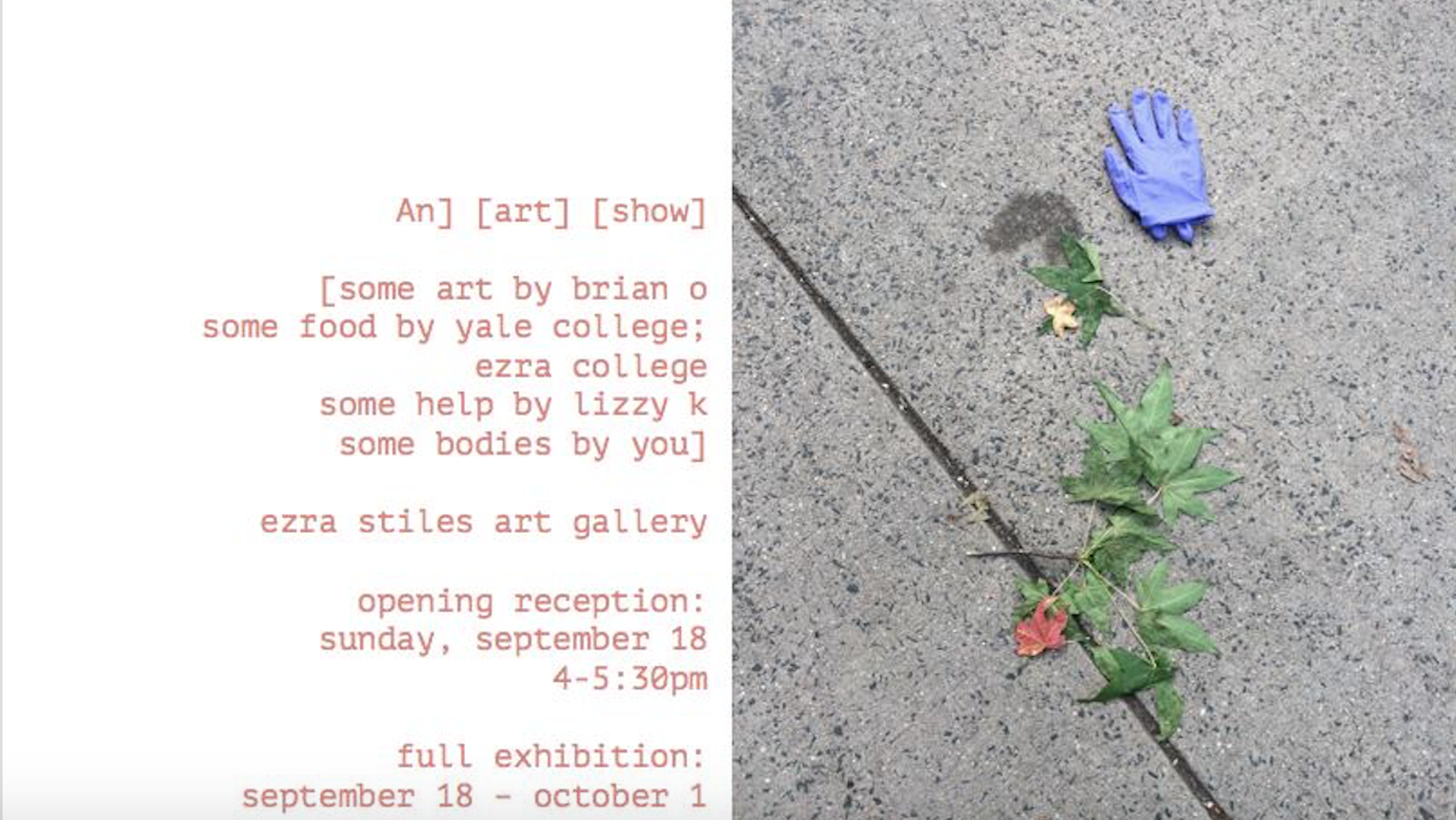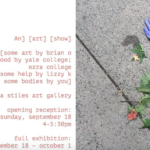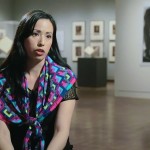by Kodi Alvord (Contributing Writer)
On September 18, An] [art] [show] made its debut in the Ezra Stiles Art Gallery, the latest public showcase from the mind of Brian Orozco ’18. At first glance, the show may be overwhelming: business cards are scattered across the gallery floor, various paintings line the walls, a damaged mirror reflects the visitors’ image, and a dusty monitor beneath undeveloped photographs glares at gallery attendants. At the center of this showcase is Brian himself, peddling away on an Ezra Stiles bike machine. When I asked him if he was part of the show, he smiled as if finally getting to tell the punch line of his favorite joke. “And so are you,” he replied with a wink.
I asked him later if was he willing to talk about his showcase, and his face lit up. We met a few days later in the gallery wherein the stationary bike was gone. The business cards covered the entire floor, except for the exact spot where the bike machine had been. That space remained clear, as if the cards were honoring the memory of Brian’s presence.
“All art is political,” Brian told me, “by virtue of you creating a piece that reflects or projects what the world looks like, or what you’d like it to look like.” I glanced around the room, at the ordered chaos that appeared to have found a home in the Ezra Stiles Art Gallery. I couldn’t help but feel that I was missing something, that somehow there was a larger message hidden in the gallery.
“You can think about art as you organizing chaos in the world… As you reacting to the world… Art-making is political too…in the sense that sometimes you’re occupying spaces that weren’t created for you,” Brian posited. He walked over to the dusty monitor in the corner of the gallery. Its power cable ran beneath a painting on the floor. Brian explained that he saw the monitor on the street outside his house, and felt that he could use it in his gallery. Indeed, the monitor cable was directly beneath a solid black line Brian had previously created across the center of his painting. “I found this ten minutes before I walked into the show”, he began, “but just because something isn’t too labored or elaborate doesn’t mean it’s arbitrary. “A lot of thought goes into ‘nothing’.”
He picked up the damaged mirror in the corner of the gallery, and twisted it around, enabling me to view it from behind. He told me that he noticed a natural blemish on the mirror, so he took sandpaper to the blemish until it was transparent. He enjoyed the shape of the transparent blotch, and painted around it to create a distinct shape. Brian explained that he’d become attached to the shape. “It’s on that painting over there, too,” he revealed, pointing to a dark yellow and black on the center wall of the gallery. I started to understand how his pieces were connected, that he had produced meaning out of apparent chaos.
Brian crossed the room and stood in front of a large, thickly painted brown and beige amalgamation of flowing currents of color. On the floor next to the painting was a highly detailed replica painting of Van Gogh’s “Starry Night”. He told me a friend painted it for him one day after he made a joke about her perfectly copying “Starry Night.” He explained that leaving it on the floor concealed another level of personal meaning, but he wasn’t disappointed if viewers would never understand that meaning.
Also discussed by Brian was how art making, too, is about engaging with a set of expectations about the art that is produced. He thought for a moment and then expounded on the idea that questioning the purpose of artmaking is an important question to ask in the context of Yale, because Yale is a society where art is “so calculated, so fact-driven.” He lingered a moment, and continued with a grin, “the show, in a sneaky, cheeky way, is about how much I can get away with.”
The brackets in his title, An] [art] [show], were meant to guard against insecurities arising from a sense that he might not get away with it. “If the show is abrasive, it’s in brackets and it’s like it never happened. This whole thing is bracketed in. It’s a set, and the moment you step out, if it didn’t work for you, that’s fine.”
He confessed that he wants to be “famous, famous, famous, but not for the reason you’d think.” His deepest passion for his art has roots in a feeling he once felt upon watching the 2012 movie Charles Fa. He paraphrased a scene in which the protagonist monologues, “‘You know what I want in life? To be at a party with somebody, and be in a crowd, and I want to make eye contact with my person on the other side of the crowd, have this world between us two. That world where I’m their person, and they’re my person. Where it’s just you two, and there’s this world between us’”.
Having looked around at his set again, Brian concluded by saying, “That’s what I hope to do with my art. I want to have that moment with as many people as I can. With whoever would like to have that moment with me. That’s why I make art, to have the opportunity to have this conversation we’re having now through my art, as succinctly and thoroughly and planned out as possible. To have a moment of saying there’s a world between us two. The average time someone spends looking at an art piece is seven seconds. So, I know I’ve got seven seconds to make that happen.”
I felt suddenly overwhelmed by the immense meaning of the exhibit. The individual pieces radiate blisteringly personal significance, hidden in artificially produced chaos. I told Brian his motivations for art-making are beautiful, and we shared a moment. He smiled, and shrugged. For Brian, it’s not always so complicated.
“I like beautiful things. And I like to make beautiful things.”


